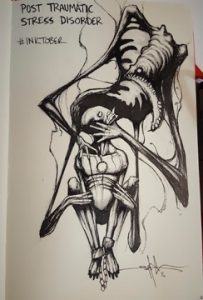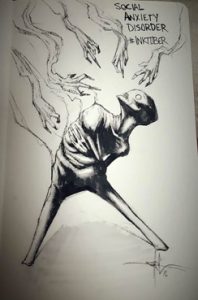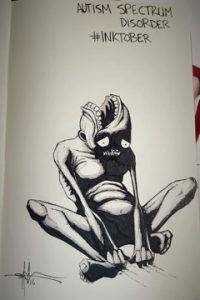Shawn Coss recently made a collection of ink sketches illustrating a compilation of different mental illnesses for the social art event of Inktober. Inktober is a social art festival encouraging artists to draw an ink sketch every day in the month of October. This collection by Coss is a portrayal of health using the humanities. Each of the sketches in the collection are drawn in a notebook with pen. The sketches all consist of a skeletal, ghoulish figure that takes on the form of both the victim and the malefactor at times. However, this technique could be used to represent victims as having a devil-like, ghost within them causing their disorder, differentiating the person and their disorder. The use of black and white as the only two colors and long pen strokes enhance the figure’s demon-like features and mangled attributes. ost of the figures are un-gendered and do not have any distinguishing attributes. These artistic elements could have been used to illustrate that these figures are within every person with this disorder. This element universalizes the disorders and allows different people to relate to his art. There are many illustrations in the collection, but the three most intriguing are the depictions of social anxiety disorder, posttraumatic stress disorder, and autism spectrum disorder.
In the depiction of social anxiety disorder, the main figure is on its knees cowered inward but looking up towards many arms and hands reaching out towards them. The figure has its own arms wrapped around itself, almost like it is cradling itself. The entire figure’s body is drawn to be facing downward and away from the outstretched hands. As a result, the stretching and strain in the form’s neck is an indicator of how aghast and petrified they are of the hands. The hands seem to be drawing something out of the figure, similar to a dementor drawing out the soul of individuals from Harry Potter’s wizarding world. The white, open wide eyes of the figure enhance the fear. Additionally, the pointed nails of the outstretched hands and their wispy nature add to its eerie nature. Interestingly, the artist did not choose to depict features of the hands and make them into full figures to illustrate the social aspect. The focus on outstretched hands signifies that someone suffering from social anxiety disorder would not see the people behind the hands but only the fearful essence that is exuded from each of them.
The illustration of posttraumatic stress disorder has two distinct full forms in it. Instead of having the victim and the illness be components of one form, the illustration has a distinct victim and perpetrator in the frame. The victim is cowering, hunched over, as their hands and legs are shackled and they are being engulfed by the other figure. The other form has wrapped their legs and arms around the victim and is holding their head up to make the victim face the form. The figure leaves them helpless and without ability to face the scary monster that looks like it might just about eat them whole with its wide, opened mouth and razor sharp teeth. There is a gaping hole in the middle of the victim’s chest. The gaping hole could represent where the monster has come out of or that the monster has already taken out the victim’s heart or soul.
The ink sketch of autism spectrum disorder has a single figure in it. The figure is leaning back almost trying to use their hands and nails to keep themselves up. The position in which they are sitting and the downward angle of sight portrays dejection. The direction of their sight could symbolize that they have been conditioned to feel inferior and scared as shown through their wide hooded eyes. The head is the key part of this sketch; the skull has teeth forming a mouth that looks as if it could be frowning and is open wide. The depiction of the skull represents that the mind is eating itself inside out and the victim cannot do anything about it but try to hold onto their surroundings and look down as no one can understand.
Many of the visitors of the ‘boredpanda’ website have shown appreciation for this collection and have commented saying that they can relate. One commenter on the social anxiety sketch states, “Your work is so beautiful and accurate. I have some of these and you have put on paper what I actually feel inside. Thank you for this.” Some applaud the sketch but critique the portrayal by saying they wish the outstretched hands were drawn as eyes staring or open mouths yelling over each other instead to be a more accurate portrayal of the disorder. Another commenter on the post traumatic stress disorder sketch describes why this sketch is so important, “Just seeing this breaks me down in tears. There’s no words that can discribe how it feels to suffer with ptsd….but this….this speaks so much more clearly than descriptive words ever could.” For the sketch of autism, there has been more criticism because autism is not a mental illness. It is a neurological/communication disorder. One commenter critiques, “I don’t think this is an accurate account of my existence. I can speak but when I do it’s as if Im speaking the wrong language. No one can understand and I end up on the sidewalk watching the world pass me by.” However, another relates, “This one actually made me cry. I have Autism AND ADHD. I get bullied alot. Ever sense I was a kid. Many people, even my own close family, don’t inderstand that sometimes I just literally speak my mind. Thank you so much!!”
Each of these sketches induces an intense reaction. However, this is the artist’s intention, for mental health is often kept behind closed doors because it is often uncomfortable and unsightly. This artist brings the dark and ugly to the light by showing people how many people suffer quietly through mental illnesses. Though it may seem to some that Coss is portraying mental illness as “mad” victims with demon-like qualities, I believe that the artist is working to abolish the stigma that goes along with mental health by portraying the suffering that these victims feel and the demons they fight. This shows that the people with these disorders are not the disorders themselves. This collection could also represent neurodiversity by relaying that these feelings are not odd or strange, but that many people can relate and that it is ok to feel the way that you are feeling.
Images Courtesy of Shawn Coss
Akhila Boyina, a junior, as an Honors student majoring in Biology and Global Studies and minoring in Chemistry.





